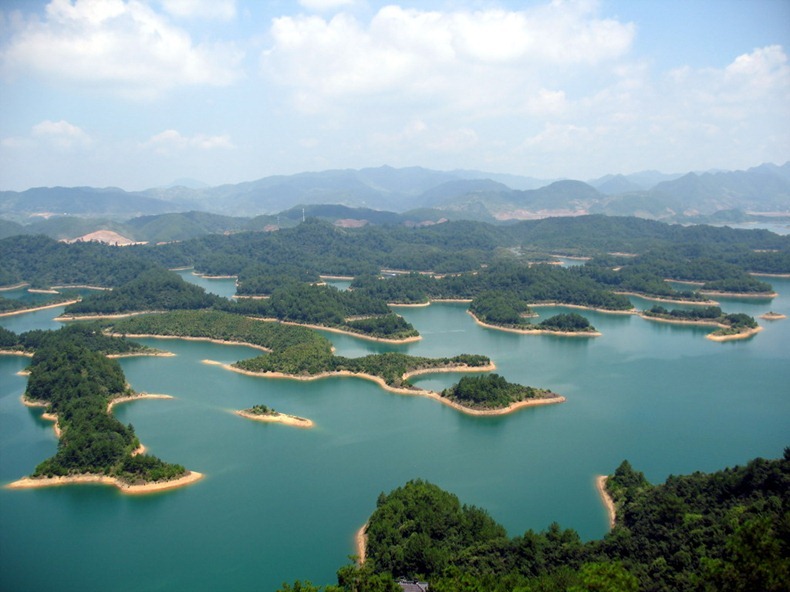Qiandao Lake or the Thousand Island Lake is located in Zhejiang, China, about 150 kilometers from the city of Hangzhou. It is an artificial lake formed after the completion of the Xin'an River hydroelectric station. In 1959, in order to build the Xin'anjiang Reservoir the valley was flooded with water resulting in a lake or reservoir 573 square km in area and with a storage capacity of 17.8 cubic km. The lake is so called because it is dotted with 1,078 large islands and a few thousand smaller ones across it.
Qiandao Lake, known for its clear, and sometimes drinkable water, is used to produce the renowned Nongfu Spring brand of mineral water. It is also home to lush forests (over 90%), and exotic islands. In recent times, it's been turned into a tourist spot with themed islands that include Bird Island, Snake Island, Monkey Island, Lock Island (featuring supposedly the world's biggest lock), and the Island to Remind You of Your Childhood.
But what lies underneath the lake is perhaps more interesting and worthy than the lake itself.
Before the valley was flooded, there stood at the foot of the Wu Shi mountain (Five Lion Mountain) two magnificent ancient cities - Shi Cheng and He Cheng. Shi Cheng was built more than 1300 years ago in 621 AD during the Tang dynasty (AD 618-907) and was once the center of politics, economics and culture. He Cheng is even older: established in 208 AD during the Han dynasty (AD 25 - 200) as a business hub along the Xin'anjiang River.

Both He Cheng and Shi Cheng were drowned in September 1959 when the Chinese government decided that it needed a new hydroelectric power station and a reservoir to feed the ever growing population in the city of Hangzhou. Along with the two ancient towns, another 27 towns, 1,377 villages, almost 50,000 acres of farmland and thousands of residential homes were flooded. About 290,000 people were relocated for the project. The complete apathy of the government towards preservation of the ancient cities is shocking.
The cities of He Cheng and Shi Cheng remained forgotten for 40 years until 2001, when Qiu Feng, a local official in charge of tourism, discussed ways to provide entertainment on Qiandao Lake with a Beijing-based diving club. He thought about utilizing the towns and asked the divers if they could dive into the water and have a look at it.
On September 18, 2001, for the first time attempt was made to reach the town. "We were lucky. As soon as we dived into the lake, we found the outside wall of the town and even picked up a brick," Qiu told in an interview. Qiu quickly reported his discovery to the local government. As more research was conducted, it was discovered that the entire town, submerged for decades, was intact. Even the wooden beams and stairs were preserved.
In 2005, the local tourism department discovered three additional ancient towns under the water. On January 7, 2011, the ancient towns were assessed as provincial level relics. In the following month, Chinese National Geography magazine printed photos of the town. Local governments were excited, but the problem of how to preserve the ancient cities remained.
Some suggested building a protective wall and pumping water out of the city. However, this method is costly, and the walls are unable to sustain pressure.
It was then suggested that the submerged towns be opened up for tourists. A 23.6 meters high, 3.8 meters tall submarine with a seating capacity of 48 seats was built at a cost of 40 million yuan ($6.36 million) for underwater visits. But since it was finished in 2004, the submarine was never used. Local officials said laws did not allow submarines to dive into inland waters. Further, no rules regulate civil submarines. Even if officially approved, the submarine might cause strong water flows under the water, which may damage the buildings.
Some experts believe the best thing to do now is nothing, as technology is limited. "Before we make use of our cultural relics, we should protect them," said Fang Minghua, former director of Chun'an County's Heritage Management Office. He said that currently, technology does not offer viable options.
Fang uses an example of two wooden beams from the ancient city that gradually began to shrink when taken out of their underwater environment and exposed to air. Water offers wood better protection; exposure to the air increases the possibility of damage. Further, the walls are delicate and might collapse due to changes in water currents. Fang suggests that sailing, fishing, or sand digging in nearby areas should be prohibited.
At the end of 2002, the Institute of Mechanics, Chinese Academy of Sciences proposed building an Archimedes Bridge, also known as a suspended tunnel. The Archimedes Bridge is a difficult project. Seven countries are doing research on it at the moment, including Norway, Japan, Swiss, Brazil, and the US. If the Archimedes Bridge for Qiandao Lake succeeds, it will be the first real Archimedes Bridge in the world.








The city of Shi cheng under water. (Photo: Chinese National Geography)

An archeologist examines the miraculously well-preserved architecture under water. [Photo: Chinese National Geography]

The splendid carvings engraved on buildings can be seen after the underwater discovery of a group of Chinese archeologists. [Photo: Chinese National Geography]

This is a restoration picture of Shicheng city in east China's Zhejiang Province. [Photo: Chinese National Geography]










0 komentar:
Post a Comment